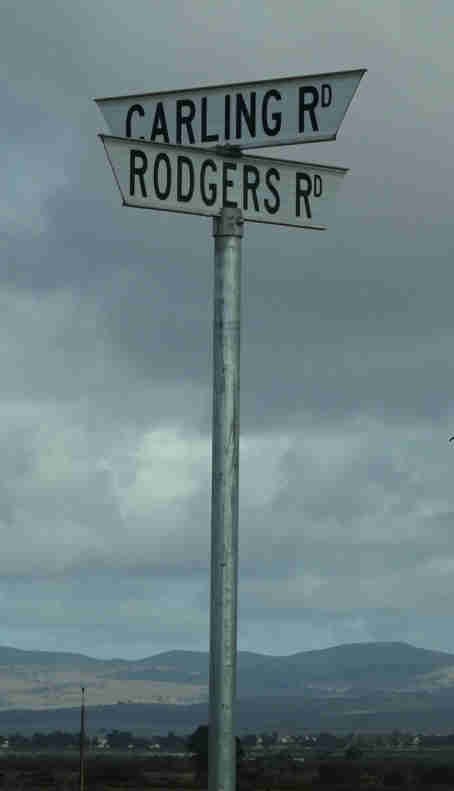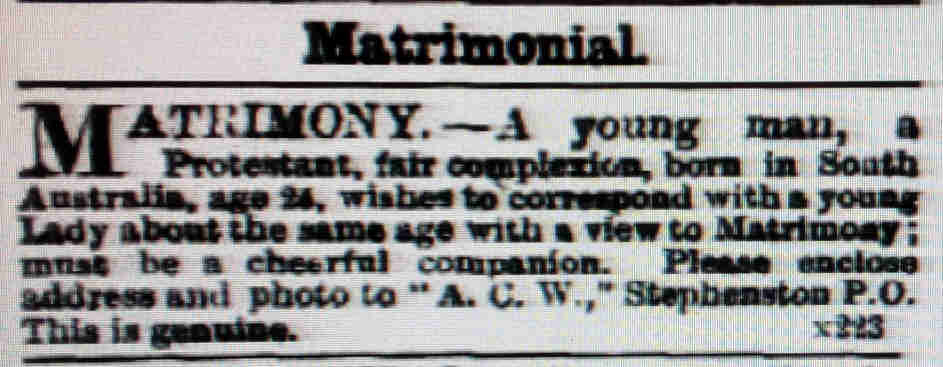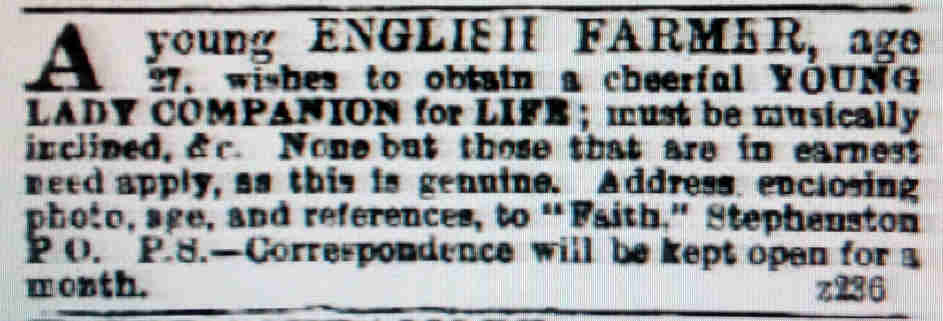


|
|
Early days at StephenstonPart 2
The New Year didnt start off very well. The weather was very hot and dry, as was usual for that time of the year. Mr Flower lost part of his uninsured haystack as a result of a fire in January 1883. If that wasnt bad enough, Mr Gale lost seven horses that had eaten a bag of wheat from one of the stacks. Although it remained very hot the Sunday School anniversary was a great success. Several sports were played and everyone had a good time. In February it was back to serious business when a meeting was held to sign a petition to get the roads fixed. They were in a deplorable state with deep gutters on both sides.
However they were in for a pleasant surprise as well when they found out that a government well-sinking party had arrived. They were in the nick of time as the supply was again very scares. On 26 March a highly successful entertainment was organised, which attracted a good attendance. Among those present were A Cocks, Florrie George, J and T Carling and L and W Symons. During the middle of autumn the iron room in which school was held was oppressively hot but there was still no stone school building on the planning board. At Round Hill E Thomas was appointed teacher but the attendance was very small and remained so for the entire time it was open. April opened with splendid rains, which really heralded the end of the drought. Wheat which had already been sown would have a splendid start. As far away as Saltia the creek was running a banker. A few weeks later there was another inch of rain which filled all the dams and in June even the Willochra Creek was running. A month later it was reported that the wheat was flourishing. Finally the farmers had something to smile about. By August though, there were fewer smiles as the Willochra was still in flood and rising, damaging many fences. In some places the creek was more than a mile wide. When Mark Hender tried to cross it with his horse and cart they were swept away, but lived to tell the tale. After a slow start the well-sinkers had struck water at a shallow depth but the supply was limited and salty. They would try a few other sites. By the end of May they called it the day but supply was still less than the demand in summer. In June a boring machine arrived at Kingswood Station which was very powerful. It was hoped that it would go deep enough to cut an artesian spring. In July it had reached a depth of 70 feet, but no water yet. A month later it was down to 120 feet but so far only salt water was cut. By the middle of September, J Hermann, who was in charge when they had struck a good supply of fresh water, decided that at 205 feet it was deep enough. Hopefully the water supply would last. Regardless of the unreliability of the rain and the past poor seasons there were still some farmers who bought land at the government land sales in Adelaide. Mark Hender bought 242 acres in section 395 at 1 per acre and 10% deposit. Another towns meeting was called for early June to again push for the roads to be repaired, more reserves for grazing and more wells. This time T Hender was in the chair and among those present were C Parsons, Mr Cocks, Mark Hender, S and A George, and Mr Wallis. In August a commonage reserve was declared at Stephenston much to everyones surprise and satisfaction, especially those with great cattle to depasture. Sheep were not allowed though.
Prospects looked good and some of the young men were game enough to look for permanent female companionship during August 1883 and August 1884. During September the town really livened up. There was first the Band of Hope Concert in which many of the locals took part. Among them were Messrs Carling, Cock, Parsons, Hender, Dunstone, Wallis and George. The ladies were represented by the misses Gale, Hender, Cousins, Parsons and George. A cricket match was played against the Quorn eleven but was lost. On the downside was the sad demise of William Herbert Wallis, twin son of T and H Wallis who died of bronchitis. In October Joseph Braddock was fined 30 shillings plus cost for assaulting Sebastian George. By December harvesting was in full swing and some farmers were paying 30 shillings a week plus board and lodging for reapers. When the harvest was in the average was about 3 bushels per acre, not very good but at least a lot better than that of the year before. On 22 January 1884 Stephenston got its first telegram. It came from nearby Bruce where a new Telegraph Office was opened. On 1 February George Howes house went up in smoke. Without hoses and only a few buckets there was little that could be done. He lost everything. A year later James Carrol lost two large haystacks, a chaffcutter and a shed when lighting struck. H Hilder lost a bullock in May !885 when it walked crossed the railway line near Kingswood and got killed. As there had been some early rain, sewing was started early. When it was finished there was even more rain in April 1884 making everyone happy. Unfortunately that was all and by May the young wheat was rapidly dying. Agricultural prospects ones again looked very poor and most farmers were despondent. On 13 May there was rain, and lots of it everywhere. Blinman had 4 inches in six days whereas Port Pirie had the heaviest rain ever. At Stephenston it rained heavily for two days, saturating the soil thoroughly. The Willochra Creek was flooded and remained impassable for some time as did some of the other creeks. Several bridges were washed away delaying the mail in most of the north. By June the roads were still in a very bad state and petitions were delivered in Adelaide to the government, but fell on deaf ears. One local wrote to the paper saying What do Adelaide people care if a few break their necks as long as they dont have to travel the same road. In July another petition went south. This time it was for a bridge across the Willochra Creek on the Quorn Road. This time the government did take notice and a bridge was constructed and opened on 11 August 1885. When it came to harvest time it turned out to be better than the previous year. Very encouraging and even though wheat prices were low a large area was put under crop in 1885. All was well but by July it was feared that the coming harvest would be a failure as no follow up rains had fallen. At the start of August a protracted drought had almost extinguished any hope of a harvest. Most farmers were desparate, having met with misfortune time and again, there was scarcely a spark of encouragement and work was at a standstill everywhere. Total yield that year was less than one bushel an acre. To make matters even worse millions of locusts ate what little wheat had survived. By September all dams were empty as were the farmers pockets. No water, wells low, no wheat, no money! For a final blow they were informed by the government that their land had been re-valued from 30 to 40 shillings an acre. This only meant higher repayments and making it almost impossible to sell. There were many complains and it is easy to understand that several farmers surrendered their credit selection and leased the land instead. What is harder to understand is that there were still farmers who bought land. Among them were J and C Pearce, JM Kelly and TH Slight. Land was still worked with animal power and feed was expensive and scarce. By March 1886 there was so little that horses were eating sand and other rubbish. A few months later both cattle and sheep were dying of starvation. Several farmers were so desperate as thinking of going to the Western Australian goldfields but leaving their families at Stephenston. At the July meeting, which was presided by Anthony Cock, to discuss conditions it was suggested to petition the government for a windmill at the main well. There was also talk about irrigation. Mark Hender proposed to ask the government for money for dams, wells and irrigation purposes. He thought a 5% interest on money so borrowed would be a fair proposition. Farmers still believed that the soil was good; it was just the lack of rain. After floods there was always a good growth. They believed that after good rains the area could produce up to 21 bushels an acre. When the harvest was finished in January 1887 the yield was very light. In many cases farmers got less than what they had put in and some didnt get enough to use for seeding. More bad news surfaced in March when typhoid was detected among the horses. The Carling Brothers had 12 horses affected by it. Luckily they all recovered. At another meeting, presided by C Meinck, it was stated that 20 years ago when the squatters held the land at a very low rental the government granted them concessions for losses of their stock during the drought. So why not grant it to farmers now? To make some extra money M Hender applied for a slaughtering licence on section 5 which was granted on 14 June 1887. W Scott pointed out that wheat growing in the district had proved to be an absolute failure and farmers would like a remission of two years rent plus an overall reduction of future rents. That same month James Broadribb put his 755 acre farm up for sale, which was held under a Credit Agreement. It included a good four-roomed stone house. After much advertising and no takers he tried to sell it at auction in January 1888. He didnt have much of a chance as another harvest had just finished giving about one or two bushels an acre. Wheat growing was certainly very disheartening. It didnt even cover expenses, let alone taxes, rents, or rates. In March the weather was still very dry, there had been no rain for a long time and only a few farmers tried to put in seed for a new crop. After a few months it became clear that there would be no crop this year. Besides the lack of rain, they also had a problem with mice and locusts. Strong hot winds blew off roofs of unoccupied houses as many residents and farmers had left. He place looked pitiable and houses and fences that had cost so much time effort and money were going to ruin. After ten years of trying Stephenston now experienced the driest season since wheat growing was started in the Hundred of Palmer. Slowly one farmer after another left, as they had no resources to keep trying. With a slowly declining population it was hard for towns people to keep services going. As businesses departed more people departed also. As early as 1884 residents had tried to get a School Board of Advice established in Quorn. They hoped that it would be able to put more pressure on the government to provide a proper school. Whereas in better watered towns there would be a natural increase in population, and therefore most likely in students, that was not the case in Stephenston where the population remained almost stagnant. There were more deaths than births and marriages were few and far between. Daniel Brinkworth, JP died at his home on 3 June 1884 leaving a wife and children to look after themselves. On 20 August 1884 William Symons married Mary Martin, eldest daughter of W Martin of Kadina. On 30 August 1887 John Sweet, eldest son of James Sweet, farmer of the Hundred of Arkaba married Anna Martin Parsons, eldest daughter of Charles Parsons, saddler of Stephenston. All were originally from Nairne. In September 1884 the residents had a very successful Band of Hope meeting where AA George and T Carling gave recitations that were well received. In May 1885 there was some talk of building a Bible Christian Church. There was also a concert on behalf of the Sunday school scholars who presented Miss George, who was leaving the district, with a handsome volume of The Girls Annual. It showed just how much she was respected and in recognition of the valuable services she had rendered as an organist. An athletic sports day was held on Good Friday 1886. All races were hotly contested and among the many prize winners were F and J McDonald, F Ferry, W McInerney, A Hutton, J Kline, F Finlay and R Meinck. During July the towns people once again requested a school. This time they got the standard reply that the government would look into the matter. Early in January 1887 the Bible Christian School with T Hender as its Superintendent, celebrated its anniversary. A very interesting talk was given by Mr A George about life on the Teetulpa Goldfield. Recitations were given by Florence George and Ursala Lewis. Miss EF Meinck played the harmonium to everyones satisfaction. On the Queens Birthday in May 1887 a grand picnic was organised at Round Hill by the teacher Mrs Cock. Scholars and teacher from the Barrindilkie School were also invited. The Stephenston Brass Band provided the music adding greatly to the days enjoyment. At the close of the day a concert was given by the Round Hill scholars conducted by Miss R George. In August 1887 A George was elected president of the Band of Hope and A Cock vice-president. The job of secretary and treasurer was entrusted to C Parsons. All three had been living at Stephenston for some years and had been active within its community. Although the town had survived, against all odds, it never became a viable town. It struggled on for many years, waxing and waning but eventually was abandoned. It had remained an insignificant town and it ceased to exist officially on 11 May 1961. |
*******

Stephenston Lone Graves
***
If you like to find out more,
![]()
![]()
please go
to home page for more information.
Thank you for visiting South Australian History,
We hope you enjoy your stay and find the information useful.
This site has been designed and is maintained by FRR.





